AR VR optics are at the heart of immersive technologies like augmented reality (AR) and virtual reality (VR), changing how we work, learn, and connect. From gaming to enterprise training, these innovations are reshaping experiences. But behind the magic lies one critical element: optics.
Optics are the foundation of immersion, delivering clarity, depth perception, and comfort that make digital worlds feel real. Without advanced lenses, displays, and optical modules, AR/VR devices would fail to engage users effectively.
In this article, we’ll explore the essentials of AR and VR, uncover how optics drive immersive experiences, examine industry applications, and look ahead to the future of this fast-growing field.
AR And VR : Understanding the Essentials

Augmented Reality (AR)
Augmented Reality (AR) adds digital content to the real world by placing images, text, or 3D objects on top of what you see around you. Common examples include AR shopping apps that let you try clothes or furniture before buying, navigation tools that show arrows on the street view, and language apps that translate signs instantly.
On the technical side, optics in AR glasses make sure these overlays look clear, bright, and well-aligned with reality. If the optics are not precise, the digital objects can appear blurry, cause eye strain, or feel out of place.
For everyday users, AR makes the real world smarter and more interactive with a digital layer that feels natural and useful.
Virtual Reality (VR)
Virtual Reality (VR) takes immersion further by transporting users into a completely simulated environment. Whether exploring a fantasy game world, practicing surgery in a safe digital space, or training pilots without risk, VR creates lifelike experiences that replace your actual surroundings.
On the technical side, VR optics are designed to provide wide fields of view (often 100° or more) and accurate depth perception, which are key to realism. High refresh rates and advanced lenses reduce distortion and motion sickness, ensuring comfort even during long sessions.
For everyday users, VR feels like stepping inside a new world, where you’re not just watching but fully experiencing it. The sense of presence is what makes VR powerful for gaming, education, and professional training.
How AR and VR Compare: Key Features, Strengths, and Limitations
| Technology | Key Features | Strengths | Limitations |
|---|---|---|---|
| AR | Digital overlays on real world | Enhances reality, lightweight | Limited immersion |
| VR | Fully immersive digital environment | High realism, deep engagement | Requires headsets, less portable |
Why Optics Define AR/VR Immersion
Optics shape how users perceive digital environments. Poor optics cause distortion, eye strain, or nausea, while advanced designs enhance realism. Key roles of optics include:
- Delivering sharp visuals with minimal distortion.
- Supporting depth perception for realistic 3D.
- Preventing motion sickness with alignment and focus accuracy.
- Integrating components such as lenses, displays, waveguides, and optical modules.
Core Optical Technologies Powering AR/VR Devices

- Fresnel lenses – lightweight but may produce glare.
- Pancake optics – folded light paths create slimmer headsets.
- Waveguides – essential for AR glasses, projecting digital content onto transparent surfaces.
- Micro OLED & MicroLED displays – enable ultra-high resolution and brightness.
Optical Technology Comparison
| Technology | Advantages | Limitations | Use Cases |
|---|---|---|---|
| Fresnel lenses | Lightweight, affordable | Glare, halo effects | Entry-level VR headsets |
| Pancake optics | Slim design, compact | Complex manufacturing | Next-gen VR headsets |
| Waveguides | Transparent, stylish | Limited field of view | AR glasses, smart eyewear |
| Micro OLED/MicroLED | High resolution, bright | High cost | Premium AR/VR devices |
How Optics Enhance the Immersive Experience
- Visual clarity & resolution: Prevents the “screen-door effect.”
- Wide field of view (FOV): 100°+ delivers more natural immersion.
- Depth perception: Accurate 3D improves realism in VR.
- Comfort & ergonomics: Lightweight optics reduce strain for long sessions.
Case study: In enterprise training, lightweight headsets with wide FOV optics enable workers to practice complex tasks safely and comfortably.
Business Advantages of AR & VR
Companies are embracing immersive technologies for:
- Customer engagement – interactive AR marketing campaigns.
- Training efficiency – safe, repeatable simulations in healthcare and aviation.
- Cost savings – reducing physical prototypes through VR simulations.
- Collaboration – AR and VR platforms that unite teams across geographies.
AR & VR Driving Change Across Industries

- Healthcare: VR surgery training and AR-assisted operations.
- Education: Immersive classrooms with 3D models.
- Retail: AR try-on solutions that boost customer confidence.
- Entertainment: Concerts, gaming, and tourism redefined.
- Enterprise: Risk-free simulations in manufacturing and logistics.
Market Growth and Adoption Trends
- Global AR/VR market projected to exceed $200 billion by 2028.
- Adoption growing fastest in Asia-Pacific due to manufacturing and consumer demand.
- Enterprise investment is rising in training, healthcare, and collaboration.
- Consumer adoption boosted by affordable headsets and AR apps.
User Experience Challenges & Considerations
- Motion sickness from poor optics alignment or refresh rates.
- Accessibility: prescription lens compatibility and comfort for glasses wearers.
- Privacy concerns with eye-tracking and data use.
- Cost barriers limiting widespread adoption.
Challenges in AR / VR Optics Today
- Distortion and chromatic aberration reduce clarity.
- Eye-box alignment issues make devices uncomfortable.
- Device weight and bulk hinder long-term use.
- High costs of precision optics slow down mass adoption.
Innovations Driving the Future of Immersive Optics
- Adaptive optics: eye-tracking with dynamic focal adjustments.
- Light field displays: natural depth perception without eye strain.
- Folded optics: slimmer and more portable headsets.
- Prescription-ready solutions: making AR/VR accessible for everyone.
Conclusion
AR & VR are no longer futuristic ideas—they are transforming industries today. At the core of these experiences are optics, enabling clarity, depth, and comfort. While challenges like distortion and costs remain, innovations in adaptive optics, light field displays, and slim headset designs are paving the way forward.
For businesses, adopting AR/VR means better engagement, cost savings, and staying ahead of competitors. For users, it means richer, more lifelike digital experiences.
Now is the time to explore how immersive optics can shape your future—because the next generation of experiences will depend on them.
FAQs
Q: What is the difference between AR, VR?
A: AR overlays digital content, VR is fully immersive blends both into extended experiences.
Q: Why are optics so important in immersive technologies?
A: Optics define clarity, comfort, and realism, making digital content believable.
Q: Which industries benefit most from AR/VR optics?
A: Healthcare, education, retail, and enterprise training are leading adopters.
Q: What challenges prevent mass adoption?
A: High costs, bulk devices, and user experience issues like motion sickness.

